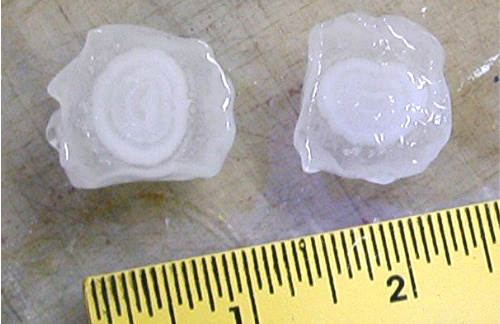It is officially spring and for everybody it means warmer temperatures, the blooming of flowers, trees, and crops, and, most importantly, severe weather. A lot of people refer spring to severe weather because that is the prime time of a year for tornades since the majority of tornadoes occur between the months of April and July. But with this kind of severe weather, there is another kind that happens much more frequently than tornadoes and that is hail storms.
Believe it or not, the growth of a hail stone is simliar to the growth of a tree. How so? Hail stones, just like trees, have growth rings. With each growth spurt there are rings inside of it that shows how many times it grew. The biggest difference is that the growth of a hail stone is much quicker than a tree.

Just looking at these hailstones, you can see that they have at least 3 inner rings and the outer, jagged edges when it was falling to indicate that it grew at least 3 or 4 times in the clouds before it fell. Amazing huh?
Here are a few interesting facts about hail:
The largest hailstone in diameter and weight ever recorded in the U.S. was 8 inches (20 centimeters) in diameter, circumference of 18.62 inches (47.3 centimeters), and weighed 1.93 pounds in Vivian, South Dakota on July 23, 2010. To put this in perspective, this is about the size of a training soccerball, which is about 17 inches in circumference, that weighs nearly 2 pounds. That's pretty big and heavy to fall from the sky!
Although the previous hailstone is the biggest in diameter and size it is not the biggest hailstone in circumference. The biggest hailstone in circumference is the famous Aurora, Nebrask hailstone on June 22, 2003 that had a circumference of 18.75 inches (47.63 centimeters). It had a smaller diameter of 7 inches (17.78 centimeters).
The costliest hailstorm in U.S. history occured on April 10, 2001 causing $1.9 billion of damage in Kansas, Missouri, and Illinois giving it the name of the Tri-state Hailstorm.
No comments:
Post a Comment